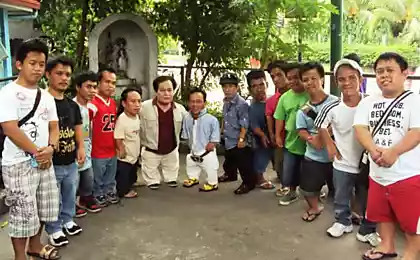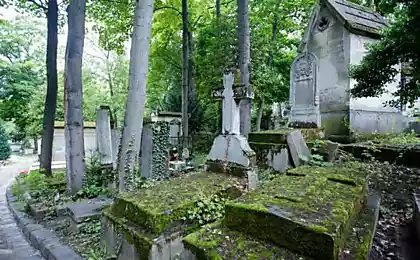1147
Residential Cemetery in Manila (18 photos)
Overcrowding Asia - a fact already required no evidence and discussions. And it's not just about such giants as China and India, but also countries' modest ».
In the Philippines, it is now home to a little more than a hundred million people, which puts this country at twelfth place in the world in terms of population. And all this in an area a little inferior to the square of Tomsk region! The population density of the island country is superior to Russia nearly 40 times, USA - 10, China - nearly 2 times! However, per capita income is very low, which makes it very spicy including the "housing problem". Especially in the capital - Manila - one of the most crowded cities in the world.
From the airplane are evident the many skyscrapers that are scattered throughout the city, but if you walk not on the main streets, and you start to realize how and where most maniltsev: often it is a home made out of tin or cardboard covered with polyethylene by frequent rains and high humidity common. Yes, the temperature here rarely falls below 25, but to live in a house made of cardboard? Many live on the streets: the concrete under the "roof" of motorways under container trucks, trucks themselves, stretching the hammock in the back ... But there is one place in Manila, where people live most unusual way, and the place is ... the cemetery.
North Cemetery in Manila (Manila North Cemetery) - one of the many cemeteries of the city, is the largest and one of the oldest cemeteries. But one thing that makes it unique - a place not only for the dead, but also home to many live - here now home to more than ten thousand Filipinos! It is fenced from all sides by a high wall and the adjacent cemeteries Cemetery La Loma and Chinese cemeteries, and to get here Europeans can only obtain a special permit in the administration of the city - the only entrance are good-natured, but well performing their duty guards.
Taking a walk through the cemetery, you can watch an ordinary life: that's someone washes clothes in a basin, someone playing with a cat, someone mends broken chair, someone preparing a meal - and all this surrounded by the graves ...



At the cemetery, there is even a transport route: here goes dzhippni - perhaps the most popular and kind of public transportation in the Philippines. It is an old (of the mid twentieth century) was an American army jeep that had been converted to carry people. Now this mode of transport is carried out in the Philippines, but it all began with the conversion of American jeeps left here.
Immediately conducted so-called "tupada" - illegal cockfights, of which so much of the province. "Sabong" - legal cockfights are held throughout the specially designed arenas and are an integral part of the pastimes of Filipinos.

For entertainment nebalovannyh Filipino children here, too, you have everything you need: those who are younger, playing some simple toys around "at home", those who are older playing football on a small platform. Well, where do without the most popular Philippine sports games - basketball - at the cemetery there is even a basketball hoop, where the play is not only teenagers, but also adults, if they are, of course, is not busy. Visit nearby school can afford only the children of those parents who earn enough to pay the tuition, most children can not attend it - because they do not have a legal address. Women are most of the time busy with household chores: cooking, washing, looking after babies, but they are a moment to exchange a game of cards directly to the grave.



There is no electricity, but it does not prevent the use of electrical appliances in the accumulators - almost all have a small radio, and in some people, and a small TV or a DVD-player - in these "kulaks" always at home a lot of guests who come to watch the news or a movie.


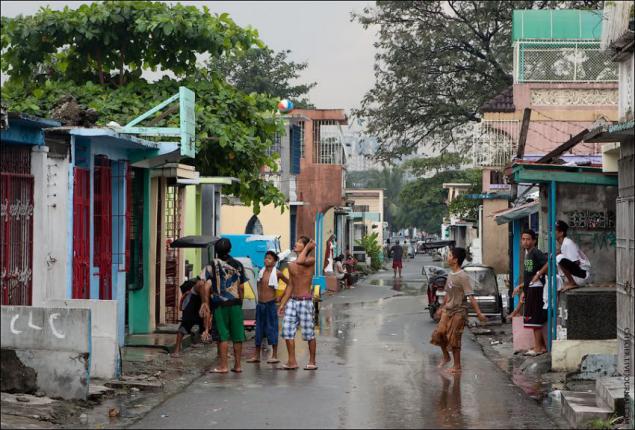
In a "home" where I was, with the permission of the owners, came by the table was laid. Lunch was fried bananas in butter, boiled sea snails and, of course, rice. The food is prepared here, as a rule, on gas stoves, but sometimes a small stake, which is diluted in a track in the middle of graves, placing its small pan for a couple of stones. Drinking water is illegally extracted from the water in Manila, and industrial water sold from the well of 3 pesos per 5 liters.
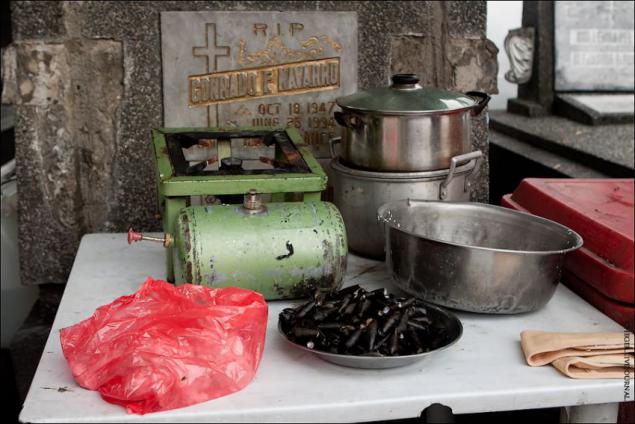

Both children and adults work part time right there in the cemetery. Someone working on a hearse driver, someone is digging the grave, someone takes care of the mausoleums richer neighbors. The children earns that is 50 pesos coffins. Here there are also volunteers, teachers, physicians, tailors, and even specialists in manicure. Despite the fact that the cemetery is huge, the place for the dead is not enough, and the funeral is not rich relatives pay a 5-year lease of the mausoleum, after which the remains of the deceased are transported in small crypts in the wall.

It must be noted that the entire population of this unusual town looks very neat. No, of course they do not wear brand-name things, but all the clothes clean and not torn, and often white t-shirts that are so fond of the inhabitants of tropical countries - all of them snow-white. And it's not a simple - it seemed to me, if the Filipino does not eat or sleep, then erases Filipino. Surprisingly neat nation, cleanliness, this is preserved even in a place like this living cemetery.


Despite the fact that the local authorities from time to time trying to kick out all the inhabitants of the cemetery, they still come back - the cemetery provides protection from prying and a no income, can not be said about life in the slums.
But the most amazing thing is that these people feel completely happy. Thus here, living in a cemetery, almost with nothing to his name, but having a large family, a roof over their head and some no job, earnings from which is enough to feed themselves and their loved ones. And the fact that they live in the cemetery. So what? Dead men do not bite ...

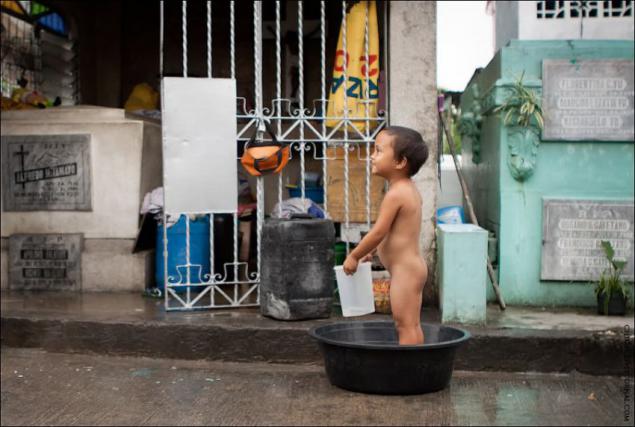
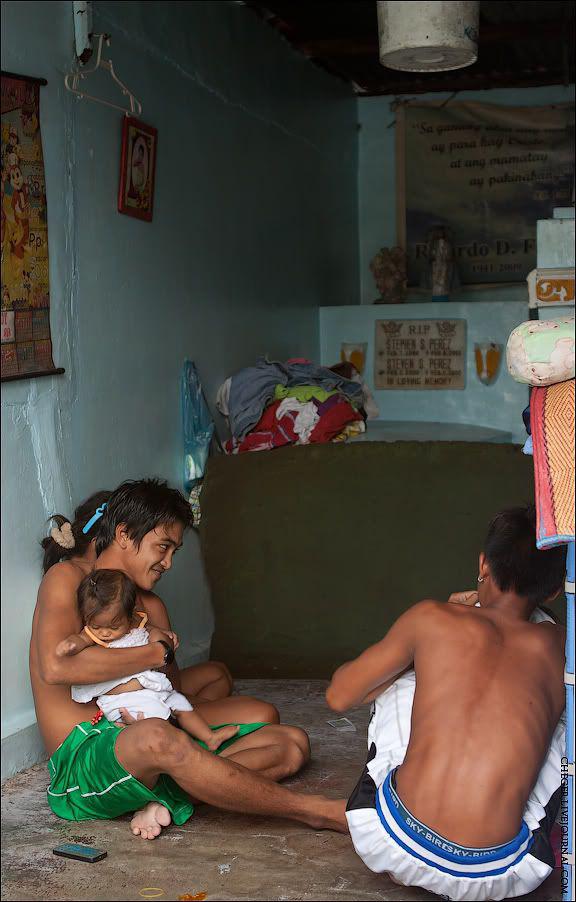
Source: cheger.livejournal.com
In the Philippines, it is now home to a little more than a hundred million people, which puts this country at twelfth place in the world in terms of population. And all this in an area a little inferior to the square of Tomsk region! The population density of the island country is superior to Russia nearly 40 times, USA - 10, China - nearly 2 times! However, per capita income is very low, which makes it very spicy including the "housing problem". Especially in the capital - Manila - one of the most crowded cities in the world.
From the airplane are evident the many skyscrapers that are scattered throughout the city, but if you walk not on the main streets, and you start to realize how and where most maniltsev: often it is a home made out of tin or cardboard covered with polyethylene by frequent rains and high humidity common. Yes, the temperature here rarely falls below 25, but to live in a house made of cardboard? Many live on the streets: the concrete under the "roof" of motorways under container trucks, trucks themselves, stretching the hammock in the back ... But there is one place in Manila, where people live most unusual way, and the place is ... the cemetery.
North Cemetery in Manila (Manila North Cemetery) - one of the many cemeteries of the city, is the largest and one of the oldest cemeteries. But one thing that makes it unique - a place not only for the dead, but also home to many live - here now home to more than ten thousand Filipinos! It is fenced from all sides by a high wall and the adjacent cemeteries Cemetery La Loma and Chinese cemeteries, and to get here Europeans can only obtain a special permit in the administration of the city - the only entrance are good-natured, but well performing their duty guards.
Taking a walk through the cemetery, you can watch an ordinary life: that's someone washes clothes in a basin, someone playing with a cat, someone mends broken chair, someone preparing a meal - and all this surrounded by the graves ...



At the cemetery, there is even a transport route: here goes dzhippni - perhaps the most popular and kind of public transportation in the Philippines. It is an old (of the mid twentieth century) was an American army jeep that had been converted to carry people. Now this mode of transport is carried out in the Philippines, but it all began with the conversion of American jeeps left here.
Immediately conducted so-called "tupada" - illegal cockfights, of which so much of the province. "Sabong" - legal cockfights are held throughout the specially designed arenas and are an integral part of the pastimes of Filipinos.

For entertainment nebalovannyh Filipino children here, too, you have everything you need: those who are younger, playing some simple toys around "at home", those who are older playing football on a small platform. Well, where do without the most popular Philippine sports games - basketball - at the cemetery there is even a basketball hoop, where the play is not only teenagers, but also adults, if they are, of course, is not busy. Visit nearby school can afford only the children of those parents who earn enough to pay the tuition, most children can not attend it - because they do not have a legal address. Women are most of the time busy with household chores: cooking, washing, looking after babies, but they are a moment to exchange a game of cards directly to the grave.



There is no electricity, but it does not prevent the use of electrical appliances in the accumulators - almost all have a small radio, and in some people, and a small TV or a DVD-player - in these "kulaks" always at home a lot of guests who come to watch the news or a movie.



In a "home" where I was, with the permission of the owners, came by the table was laid. Lunch was fried bananas in butter, boiled sea snails and, of course, rice. The food is prepared here, as a rule, on gas stoves, but sometimes a small stake, which is diluted in a track in the middle of graves, placing its small pan for a couple of stones. Drinking water is illegally extracted from the water in Manila, and industrial water sold from the well of 3 pesos per 5 liters.


Both children and adults work part time right there in the cemetery. Someone working on a hearse driver, someone is digging the grave, someone takes care of the mausoleums richer neighbors. The children earns that is 50 pesos coffins. Here there are also volunteers, teachers, physicians, tailors, and even specialists in manicure. Despite the fact that the cemetery is huge, the place for the dead is not enough, and the funeral is not rich relatives pay a 5-year lease of the mausoleum, after which the remains of the deceased are transported in small crypts in the wall.

It must be noted that the entire population of this unusual town looks very neat. No, of course they do not wear brand-name things, but all the clothes clean and not torn, and often white t-shirts that are so fond of the inhabitants of tropical countries - all of them snow-white. And it's not a simple - it seemed to me, if the Filipino does not eat or sleep, then erases Filipino. Surprisingly neat nation, cleanliness, this is preserved even in a place like this living cemetery.


Despite the fact that the local authorities from time to time trying to kick out all the inhabitants of the cemetery, they still come back - the cemetery provides protection from prying and a no income, can not be said about life in the slums.
But the most amazing thing is that these people feel completely happy. Thus here, living in a cemetery, almost with nothing to his name, but having a large family, a roof over their head and some no job, earnings from which is enough to feed themselves and their loved ones. And the fact that they live in the cemetery. So what? Dead men do not bite ...



Source: cheger.livejournal.com










